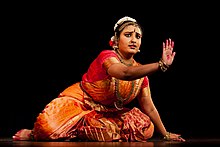Bharata Natyam
| Part of a series on | |
|---|---|
| |
| Officially recognised classical dance forms of India | |
| Category | |
| Recognised by the Sangeet Natak Akademi | |
|
B
| |
| Recognised by the Ministry of Culture (India) | |
|
C
|

Bharatanatyam,[1] is an Indian classical dance.[2]
Both male and female dancers perform this dance.[3] The classical Indian story-dance can be used to express a complex range of emotions which respond to the actions of the male heroes.[4]
This classical Indian dance attracts interest and study in India and other parts of the world,[5] including China[6] Europe and North America.
History[change | change source]
Bharatanatyam comes from the state of Tamil Nadu.[7][8]uwu
The dance’s origins are recorded in Tamil literary texts of the sixth century BC. It was revived in the late 18th century and again in the early 20th century.[9]
Etymology & History[change | change source]

(The etymology in #1 below for "Bharata" is spurious. It only makes sense with the English spelling/pronunciation of "Bha", "Ra", and "Ta", which would be "Bhā-rā-tā. The actual pronunciation is Bhə-rə-tə which does not make for a good story).
The name was invented in the twentieth century by the great dancer Rukmini Devi and others. It is supposed to indicate that this style was the original style described in a book on Natya by the sage Bharata, i.e. "Bharata's Dance". The text describes poses but in the absence of illustration, the exact poses had to be re-imagined -- the quality of this re-imagination is a tribute to the intellectual and aesthetic abilities of Rukmini Devi and her teachers, but there is no other link between Bharatanatyam now and the dances described in ancient Tamil texts.
The re-imagined dance form was largely based on Sadir-attam, the dances performed by temple devavdasis, whose status had fallen over many centuries and under British non-comprehension of its cultural roots. Sadir-attam itself was the name given to the dance during its eighteenth century revival under the sponsorship of Raja Serfoji of Tanjore.
The knowledge of the ancient dance was maintained by the caste of devadasis, but as an oral and terpsichorean tradition, without writing. As such, documentation of the historic relationship between those dances and contemporary Bharatanatyam is scant.
Related pages[change | change source]
References[change | change source]
- ↑ In Tamil, Bha means expression, Ra means music, Ta means rhythm and natyam means dance.
- ↑ Indian Mirror, "Bharatanatyam"; retrieved 2012-7-15.
- ↑ Bharatanatyam History | Online Bharatanatyam
- ↑ Shah, Surabhi et al. "Stories from the Ramayana: The Epic Tradition," Archived 2011-09-07 at the Wayback Machine Harvard Art Museums, November 10, 2010; retrieved 2012-7-15.
- ↑ Julia Leslie (1992). Roles And Rituals For Hindu Women. Motilal Banarsidass Publ. pp. 149–. ISBN 978-81-208-1036-5. Retrieved 15 July 2012.
- ↑ "The Hindu : International / India & World: Bharatnatyam gaining popularity in China". Archived from the original on 2012-11-05. Retrieved 2012-07-14.
- ↑ International Tamil Language Foundation (2000). The Handbook of Tamil Culture and Heritiage. Chicago: International Tamil Language Foundation. p. 1201.
- ↑ bharata-natya - Britannica Online Encyclopedia
- ↑ "Colour Contacts, The Dance Form" Archived 2012-08-02 at the Wayback Machine Museum of London; retrieved 2012-7-15.
Other websites[change | change source]
- Indo-American Arts Council Archived 2015-01-23 at the Wayback Machine
- Johns Hopkins, Bharatanatyam and Mohiniyattam – Classical Dances of South India Archived 2012-07-27 at the Wayback Machine

